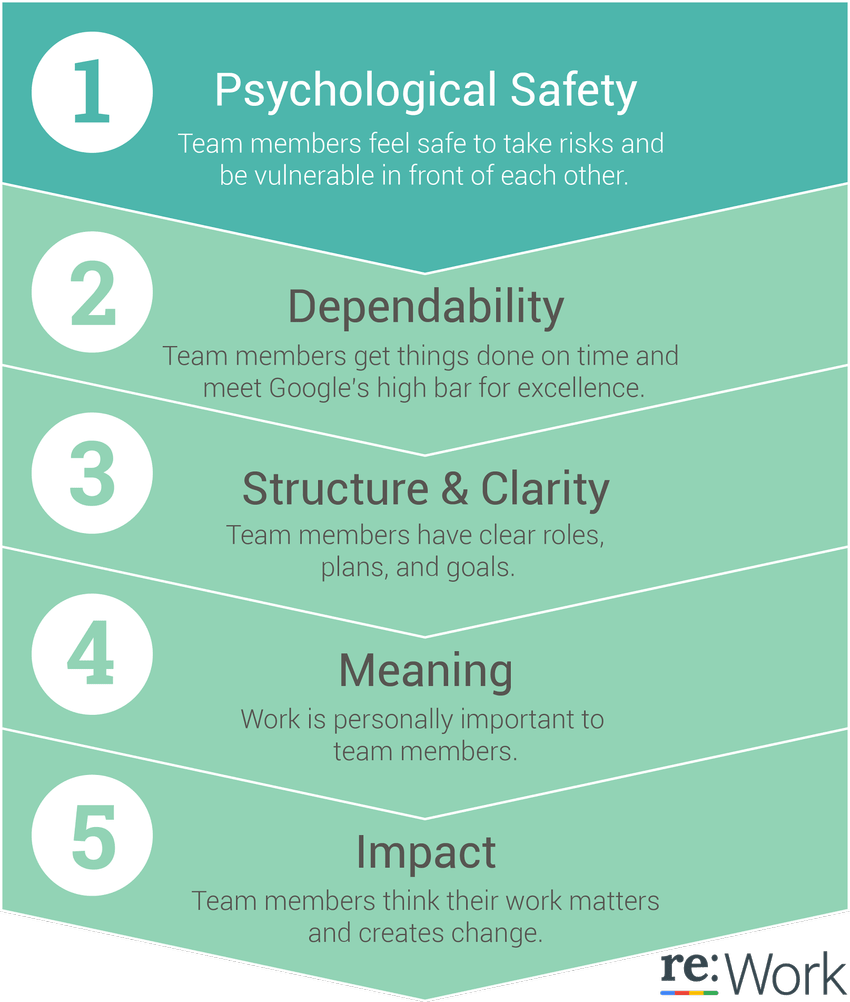
Many companies seek to improve employee productivity. However, with people usually working in groups, a question arises whether factors that boost individual performance are the same factors that help team succeed.
A while ago, Google embarked on the so-called project Aristotel, a quest to discover the recipe for what makes a perfect team. The research was named after Aristotel’s famous maxim:
The whole is greater than the sum of its parts.
Google wanted to see if conventional wisdoms (e.g. that people who share the same views work better together) would hold true in the face of hard numbers. Needless to say that the search giant was in a perfect position to carry out this study, because it had a large pull of teams to draw upon for data.
Five traits of uber-productive teams
When the study results came out (in early 2016), they surprised many. Variables such as group composition, sitting in the same office and individual team member performance were discovered to have insignificant impact on team productivity.
Instead, what was proven to be of significance were psychological, structural and motivational aspects of group work.

So, what is it that makes teams highly productive?
Trait 1: They are no-fear zones
Innovation, creativity and other things we expect from great teams thrive in psychologically-safe environments. What are these? They are places where people are not afraid to share their thoughts, voice their doubts, or ask questions.
As a leader, you can do certain things to establish a psychologically-safe environment.
First, solicit opinions and feedback from your team. At meetings, stay genuinely interested in what speakers have to say (look up from your phone and make eye contact with the speaker). Don’t interrupt or allow others to interrupt their fellow group members. It’s important that everyone talks for the same amount of time, so that each person feels equally appreciated.
Second, avoid being negative or placing blame. Instead of saying something like “Why did you do this?”, handle it constructively by saying “Okay, what can we do to prevent this from happening in the future?”
If you hear a team member talk negatively about another team member, let them know such behavior is unacceptable. Environments where badmouthing and gossip are rampant quickly become “toxic” and unsafe-to-be-in places.
Third, lead by example. Show your juniors you are also fallible, and invite them to find weak points in your perspective.
Trait 2: Each team member is dependable
Dependability (as defined by Google in the above research) is one’s ability to deliver quality work on time.
There are two major pitfalls that can crumble employee dependability: (1) lack of individual work transparency and (2) poor strategy for distributing responsibilities within the team.
Work transparency means each employee has a clear understanding of what is expected of them and knows exactly on what basis their work is being evaluated.
When splitting tasks among team members, make sure that no work is left without an explicit owner. For example, if you have a 100% piece of work that you want to distribute between 3 employees, don’t leave out 10% as no particular person’s responsibility.
Of course it’s hard to account for each micro action, and sometimes people work in pairs or in larger sub-groups. Still, you can strive to promote task ownership wherever possible, and to split work in such a way as to minimize responsibility shrinking and free-riding.
Trait 3: Good structure and clarity
High-performing teams tend to be good at organizing their joint activities and communications. Their meetings have strictly defined agenda and good moderators. At meetings, team members learn what others are doing, and how individual contributions count towards the greater goal.
Besides, they have clarity as to what goals the team is trying to achieve. Clearly defined goals add to higher job purpose awareness – what are we here to do? Team goals should be communicated to the entire group consistently.
Google propagates setting goals that are (A) challenging and (B) specific. They call it the Objectives and Key Results (OKR) approach, under which goals are actually NOT expected to be met 100%.
According to Google:
The sweet spot for an OKR grade is 60% – 70%; if someone consistently fully attains their objectives, their OKRs aren’t ambitious enough and they need to think bigger.
Trait 4: Employees find work meaningful
There is no single way to define “meaning” in this case, because your team may find it at different levels.
Some employees may be motivated by the financial security their job provides and care little about the tasks they are assigned.
Others give their best when their work provides space for self-realization. In this case, it is important to take into account not only one’s professional strength, but also their interests when assigning tasks to such people. To discover what your team members prefer to do, simply ask them.
At the highest level, the motivation can be making the world a better place. This is often true of tech startups, IoT firms, scientific labs and similar companies.
If your organization is like that, fill your hallways and coffee stands with posters about “the cause”. Studies have shown that this helps instill in employees a sense of pride for working at the company.
Trait 5: Members feel their contribution counts
Fund-raising organizations are effective at making their donors feel that each contribution matters.
The day after the Thailand tsunami struck, Starbucks cafes in the U.S. were full of green paper slips where people could write their names for just $1. The slips were then hung around the cafe, sporting donors’ names.
It is beneficial if your employees can see how the work they do impacts the company’s performance.
What you can do is survey your employees to see if they realize how their individual contributions impact your clients / product users. If your team has difficulty determining that, work towards more clarity and individual work recognition.
For instance, some companies give credit (in their emails and blog posts) to individual programmers, designers and other people who have contributed to a product update, etc.
In conclusion
As you may see, there is more to work productivity than simply striving to make your employees productive individually (by doing things like buying them standing desks, for example).
Also, team productivity depends on how the team is managed, and what culture, values, motivation and organization the manager promotes.
While Google says the principles they discovered may not be valid for all work environments, why not give them a shot your work place?